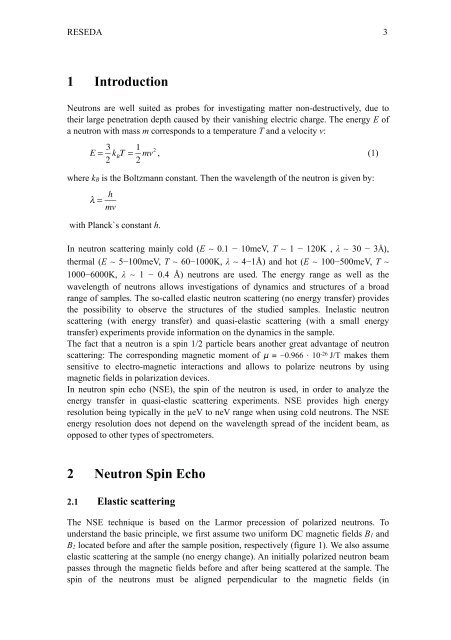Neutron Scattering - JUWEL - Forschungszentrum Jülich
Neutron Scattering - JUWEL - Forschungszentrum Jülich
Neutron Scattering - JUWEL - Forschungszentrum Jülich
Create successful ePaper yourself
Turn your PDF publications into a flip-book with our unique Google optimized e-Paper software.
RESEDA 3<br />
1 Introduction<br />
<strong>Neutron</strong>s are well suited as probes for investigating matter non-destructively, due to<br />
their large penetration depth caused by their vanishing electric charge. The energy E of<br />
a neutron with mass m corresponds to a temperature T and a velocity v:<br />
E = 3<br />
2 kBT = 1<br />
2 mv2 , (1)<br />
where kB is the Boltzmann constant. Then the wavelength of the neutron is given by:<br />
λ = h<br />
mv<br />
with Planck`s constant h.<br />
In neutron scattering mainly cold (E ∼ 0.1 − 10meV, T ∼ 1 − 120K , λ ∼ 30 − 3Å),<br />
thermal (E ∼ 5−100meV, T ∼ 60−1000K, λ ∼ 4−1Å) and hot (E ∼ 100−500meV, T ∼<br />
1000−6000K, λ ∼ 1 − 0.4 Å) neutrons are used. The energy range as well as the<br />
wavelength of neutrons allows investigations of dynamics and structures of a broad<br />
range of samples. The so-called elastic neutron scattering (no energy transfer) provides<br />
the possibility to observe the structures of the studied samples. Inelastic neutron<br />
scattering (with energy transfer) and quasi-elastic scattering (with a small energy<br />
transfer) experiments provide information on the dynamics in the sample.<br />
The fact that a neutron is a spin 1/2 particle bears another great advantage of neutron<br />
scattering: The corresponding magnetic moment of μ = −0.966 · 10 -26 J/T makes them<br />
sensitive to electro-magnetic interactions and allows to polarize neutrons by using<br />
magnetic fields in polarization devices.<br />
In neutron spin echo (NSE), the spin of the neutron is used, in order to analyze the<br />
energy transfer in quasi-elastic scattering experiments. NSE provides high energy<br />
resolution being typically in the μeV to neV range when using cold neutrons. The NSE<br />
energy resolution does not depend on the wavelength spread of the incident beam, as<br />
opposed to other types of spectrometers.<br />
2 <strong>Neutron</strong> Spin Echo<br />
2.1 Elastic scattering<br />
The NSE technique is based on the Larmor precession of polarized neutrons. To<br />
understand the basic principle, we first assume two uniform DC magnetic fields B1 and<br />
B2 located before and after the sample position, respectively (figure 1). We also assume<br />
elastic scattering at the sample (no energy change). An initially polarized neutron beam<br />
passes through the magnetic fields before and after being scattered at the sample. The<br />
spin of the neutrons must be aligned perpendicular to the magnetic fields (in

















